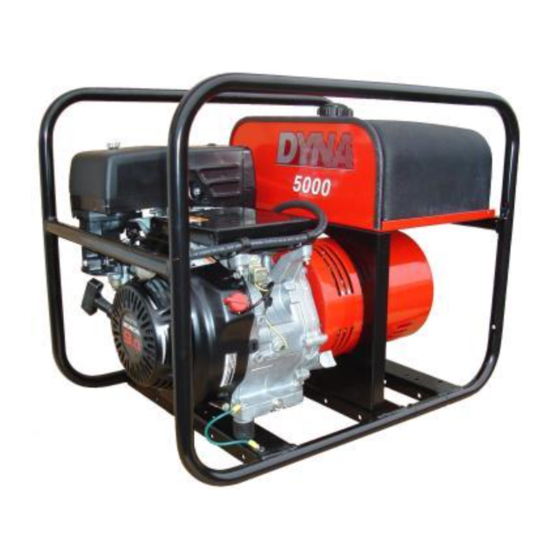Dyna DL5000H Panduan Petunjuk Pemasangan & Pengoperasian - Halaman 9
Jelajahi secara online atau unduh pdf Panduan Petunjuk Pemasangan & Pengoperasian untuk Generator Portabel Dyna DL5000H. Dyna DL5000H 12 halaman. Portable generators

BASIC OPERATION
3. Automatic Idle is in the 'Off' position
4. Visually for loose parts.
STARTING
The throttle control on these generators is preset and locked
to operate at 3600 RPM (nominal) with no load speed set at
3750 RPM. Only a trained service technician should be
allowed to adjust this speed setting. See "Operating Speed"
section for additional information.
NOTICE: ENGINE START LOCKOUT
This unit will not start if it is low on oil. The lubricating oil
level must be at the full mark before the engine will start.
MANUAL STARTING - Refer to the engine manual for
additional starting, operating, and stopping instructions.
NOTICE: TRI-FUEL STARTING
Tri-Fuel generators operating on vapor fuel, (either L.P. or
NG) must be started using the electric start system
provided. You cannot hand crank the unit fast enough to
develop the proper vacuum to make the vapor fuel system
work. In addition the demand regulator on the DL6000TFE
has a primer button, in the center of it, which must be
depressed, while engaging the starter. WHEN USING
VAPOR FUEL NEVER USE THE CHOKE. Use of the choke
will prevent the air and fuel from properly mixing.
1. Turn on the fuel supply.
2. Move the choke to the full "on" position. A warm engine
will require less choking than a cold engine.
3. Grasp starter grip and pull slowly until starter engages,
then pull cord rapidly to overcome compression,
prevent kickback and start the engine. Repeat if
necessary.
4. When the engine starts, open the choke gradually.
5. The engine should promptly come up to operating
speed.
Electric Starting - If the engine is cold and stiff or if the battery
is not fully charged, starting can be made easier by slowly
hand cranking the engine through the compression stroke
before pushing the starter switch. This permits the starter to
gain momentum before the heavy load of the compression
stroke occurs. This minimizes the drain on the battery and
improves the possibility of starting under such adverse
conditions. Always keep the battery charged, but especially
during cold weather operation.
1. Turn on the fuel supply.
2. Move the choke to the full "on" position. A warm
engine will require less choking than a cold engine.
3. Engage the engine start switch briefly to the START
position. The starter life is improved by using shorter
starting cycles with time to cool off between cranking
cycles. Do not operate the starter more than 15
seconds during each minute. Repeat if necessary.
4. When the engine starts, open the choke gradually.
5. The engine should promptly come up to operating
speed.
CAUTION: EQUIPMENT DAMAGE
Never permit the choke to remain on after the engine has
run for a short time. It is not necessary to choke the
engine when it is warm. Avoid over-choking.
60707-110
STARTING HINTS
1. Cold weather
a. Use the proper oil for the temperature expected.
b. Use fresh winter grade fuel. Winter grade
gasoline is blended to improve starting. Do not
use summer gasoline.
c. A slightly richer fuel mixture will usually improve
cold starting.
2. Hot weather
a. Use the proper oil for the temperature expected.
b. Use only summer blended gasoline. Using
gasoline left over from winter may cause the unit
to vapor lock.
c. DO NOT over-choke the unit.
STOPPING AND STORAGE
1. Depress the metal stop strip on top of the engine to
'ground out' the spark.
2. Before extended storage (over 30 days) certain
precautions must be taken to ensure the fuel doesn't
deteriorate and clog the fuel system. Note: The use of
a fuel additive, such as STA-BIL, or an equivalent, will
minimize the formation of gum deposits during
storage. Such an additive may be added to gasoline
in the engine's fuel tank or to gasoline in a storage
container.
a. Remove the remaining fuel from the fuel tank.
b. Start the engine and allow it to run until all
the fuel in the carburetor and the fuel lines has
been used up and the engine stops.
c. While the engine is warm, drain the oil and
refill with fresh oil.
d. Remove the spark plug, pour approximately
1/2 ounce (15 cc) of engine oil into the cylinder
and crank slowly to distribute oil. Replace spark
plug.
e. Clean dirt and chaff from cylinder, cylinder
head fins, blower housing, rotating screen and
muffler areas.
f. Store in a clean and dry area.
OPERATING SPEED
The engine-generator must be run at the correct speed in
order to produce the proper electrical voltage and frequency.
CAUTION: EQUIPMENT DAMAGE
The output voltage should be checked to insure the
generator is working properly prior to connecting a load
to the generator. Failure to do so could result in damage
to equipment plugged into the unit and possible injury to
the individual.
All engines have a tendency to slow down when a load is
applied. When the electrical load is connected to the
generator, the engine is more heavily loaded, and as a
result the speed drops slightly. This slight decrease in
speed, together with the voltage drop within the generator
itself, results in a slightly lower voltage when the generator
is loaded to its full capacity than when running no load. The
Page 7
DYNA SERIES 5/97
